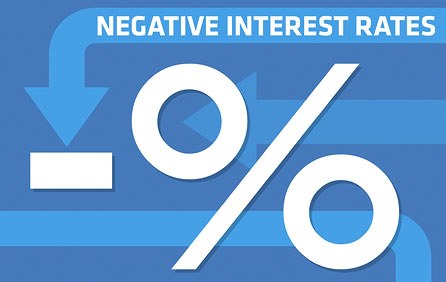 An interest rate, or rate of interest, is the amount of interest due per period, as a proportion of the amount lent, deposited or borrowed . The total interest on an amount lent or borrowed depends on the principal sum, the interest rate, the compounding frequency, and the length of time over which it is lent, deposited or borrowed. A negative interest rate policy (NIRP) is an unconventional monetary policy tool whereby nominal target interest rates are set with a negative value, below the theoretical lower bound of zero percent.
An interest rate, or rate of interest, is the amount of interest due per period, as a proportion of the amount lent, deposited or borrowed . The total interest on an amount lent or borrowed depends on the principal sum, the interest rate, the compounding frequency, and the length of time over which it is lent, deposited or borrowed. A negative interest rate policy (NIRP) is an unconventional monetary policy tool whereby nominal target interest rates are set with a negative value, below the theoretical lower bound of zero percent.
Interest rates are generally assumed to be the price paid to borrow money. For example, an annualized 2% interest rate on a $100 loan means that the borrower must repay the initial loan amount plus an additional $2 after one full year. On the other hand, a -2% interest rate means the bank pays the borrower $2 after a year of using the $100 loan, which is a lot to wrap your head around. While negative interest rates are a great incentive to borrow, it's hard to understand why anyone would be willing to pay to lend considering the lender is the one taking the risk of a loan default.
Negative yields mean that if an investor places a deposit with a bank at maturity the investor receives back an amount less than the original investment. In effect, the depositor pays to place money with the bank. In the case of bonds, negative yields mean that investors accept an economic loss, as the price paid by the investor is greater than the present value of the interest payments and principal repayment for a security. Negative real rates entail return on the amount invested but loss of purchasing power because inflation rates are greater than the return. Negative nominal rates involve a guaranteed loss of capital invested.
Theoretically, targeting interest rates below zero will reduce the costs to borrow for companies and households, driving demand for loans and incentivizing investment and consumer spending. Retail banks may choose to internalize the costs associated with negative interest rates by paying them, which will negatively impact profits, rather than passing the costs to small depositors for fear that otherwise they will move their deposits into cash.
While negative interest rates may seem paradoxical, this apparent intuition hasn't kept a number of European central banks from giving them a try. This is no doubt evidence of the dire situation that policymakers believe is characteristic of the European economy. Though fears that bank customers and banks would move all their money holdings into cash did not materialize, there is some evidence to suggest that negative interest rates in Europe cut down interbank loans.







